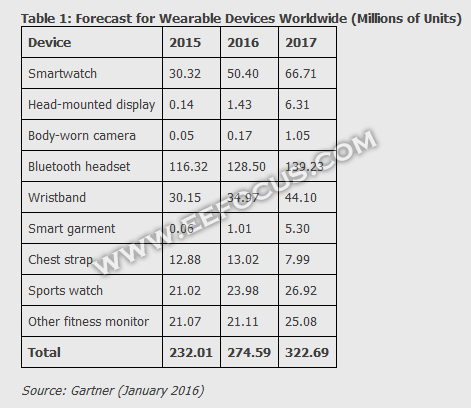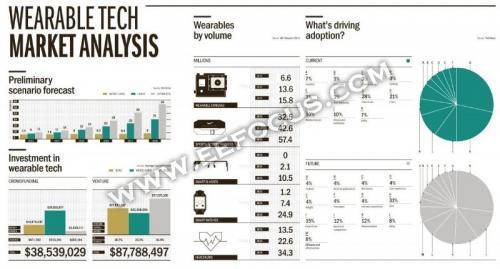Ten highlights of Wearable technology
Time:2023-07-31
Views:796
Although the wearable device market is not yet mature, it is still growing. Now there are about 160 types of wearable devices in the world, such as track tracking devices, smart watches, Smartglasses, and embedded sensors that are safe in clothes. IDTechEX predicts that the wearable device market will reach 70 billion dollars in the next decade. With technological progress and the continuous launch of new products, wearable products are rapidly entering human life and changing the way humans live. A major branch of wearable products is healthcare wearable products, such as devices for caring for the elderly and infants, wearable devices for monitoring sleep and health status. Of course, the best-selling wearable devices now are smartwatches and sports bracelets.


Gartner predicts that the global shipment volume of wearable devices will reach 274.6 million units in 2016, an increase of 18.4% compared to the 232 million shipment volume in 2015. In 2016, wearable device sales reached $28.7 billion, with smartwatches accounting for approximately $11.5 billion.

Relying on Apple‘s ability to lead the trend, the acceptance rate of smartwatches will increase by 48% from 2015 to 2017. From now to 2019, smartwatches may be the largest branch of the wearable market, with sales reaching $17.5 billion, "Gartner said in a report.
In the coming years, the top ten highlights of Wearable technology are as follows:
1. Opportunity: According to PwC‘s prediction, the entertainment, media, and communications (EMC) industry will create the greatest opportunity for the growth of the wearable market. Basically, as long as there are screen applications, there will be wearable opportunities, and the EMC industry is such an application. If the estimation is good, the shipment volume of wearable products in these industries in 2018 can reach 130 million units, which is naturally a great opportunity.
2. Humanized device selection: Users may need a more user-friendly way to select devices and their related applications (apps). For example, using an app formula that has been certified by medical professionals to help users select suitable devices and applications from thousands of health applications and devices.
3. Wearable devices will benefit from social media: social media has become the basic way to receive information and communicate with others. With the help of wearable devices, it can precisely meet the needs of users to access social networks anytime and anywhere. Millennials update social media three times more frequently than ordinary people, and social media will greatly benefit wearable devices.
4. Auxiliary treatment of chronic diseases is one of the driving forces for the growth of wearable products: from the perspective of the United States, consumer and medical applications are also one of the driving forces for the growth of the wearable market. Especially with the increase of incidence rate of chronic diseases such as diabetes, wearable products have more and more market space. Sports bracelets and smart watches also integrate health functions, but the application performance of these products in health care is still unsatisfactory.
5. Data collection using Wearable technology: using the data collected by wearable devices, insurance companies or employers can better manage health care costs, pharmaceutical and life science companies can do more clinical trials, and medical service companies can decide to reimburse expenses based on the collected data. With the continuous enhancement of computing power, wearable devices have become very small in size, making them popular among young people. They will transmit these valuable Health data to thousands of miles away through an iPhone application, including watches recording fitness data, heart rate monitoring and other wearable health devices. Of course, commercial companies need to consider cost, user privacy, and ease of use when collecting this data.
6. Attract the attention of health conscious users: From a smart watch that records heart rate to a smart bracelet that tracks movement, more and more health conscious users begin to pay attention to the application of Wearable technology in medical health. One of the two major purposes of developing Wearable technology is to detect the user‘s body state and synchronize these data to the parent device such as smart phones. Of course, some wearable devices can also calculate on the device itself, and perform corresponding actions according to the calculation results, such as whether to use drugs for patients.
7. Value mining for new applications: Many large companies are launching smart watches and smart bracelets. With the addition of giants like Apple and Samsung, the appearance and user experience of wearable products will be significantly improved. Veteran manufacturers of smart wristbands like Fitbit are starting to consider how to compete with smart watches. In addition to fitness applications, smart bracelets are expanding into new application scenarios, such as mobile payments, identity authentication, security, and health.
8. Fitness applications: Due to the promotion of government health programs in the United States, wearable devices for fitness applications such as smart wristbands, smart clothes, smart chest straps, and smart sports watches are becoming increasingly popular. In 2016, smartwatches will be the most popular among these types of applications, as they integrate multiple functions to facilitate users‘ tracking of exercise results.
9. Bringing new technologies: To gain the trust of users in the wearable field, enterprises must always adhere to transparency in data operations. For data related to user privacy, enterprises need to inform users of what operations have been carried out on this data and where it will be used. The Wearable technology based on organic electronics can now produce flexible displays and sensors. These technologies are widely used in wearable devices, mobile devices, industrial devices, automobiles and biomedical devices.
10. Embrace Wearable technology: Only by focusing on users and improving user experience to reshape enterprise values and system capabilities can Wearable technology be developed more effectively. Nowadays, most wearable products are used for wrist wear, but with the development of flexible circuits, wearable devices will increasingly appear in other forms, such as clothing, accessories, and shoes. Wearable devices and applications help users record their heart rate and meal status, monitor their psychological state, and even detect the surrounding air quality. For ordinary people, being a ‘healthy self‘ has become a reality.
summary
CSC Insight, a market analyst, said that the shipment of wearable devices will increase from 29 million in 2014 to 172 million in 2018, with the peak in 2015. Fitbit and Jawbone will still dominate the wearable market. CSC Insight predicts that the shipment volume of fitness and activity tracking wearable devices will reach 40 million in 2016, doubling from 2015. The global wearable market size reached 31.27 billion US dollars in 2020, with a compound annual growth rate of 17.8% from 2015 to 2020.

Although the market prospects for wearable devices are promising, the acceptance of wearable devices by users will be a long-term process. The use of wearable devices for commercial purposes is now a direction that many companies are considering.
|
Disclaimer: This article is transferred from other platforms and does not represent the views and positions of this site. If there is any infringement or objection, please contact us to delete it. thank you! |











